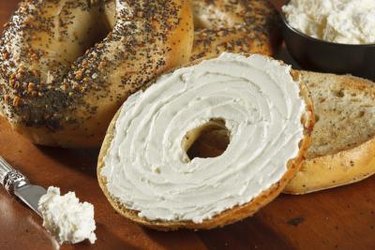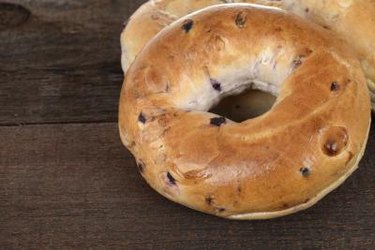
Bagels made their entrance in New York in the 1880s, when a flood of Jewish immigrants from Eastern Europe streamed into the country. In the 1960s, they started to be produced in large quantities for sale. The bread slicer was invented in the 1920s, and sliced bread has been a household staple ever since. Bagels and bread not only differ in look, but in calorie count and nutritional value as well.
Calorie Count Comparison
Video of the Day

Bagels are not an even substitute for sliced bread, based on calories. Just one plain white bagel can account for about 300 calories, compared to around 90 calories per plain slice of white bread, according to Being Healthy TV. Half a bagel is a better substitute for morning toast, but remember that it will still equal almost two slices of bread in caloric content.
Video of the Day
Bagels

Compared to bread, bagels are more commonly topped with higher calorie foods. If you add about 2 tbsp. of regular cream cheese to your bagel, you are adding about 100 calories and 6 g of fat. However, bagels themselves are low in saturated fats, but are also typically low in fiber. Bran or whole wheat types of bagels are a bit healthier, with more fiber than the standard enriched white flour bagel.
Bread

White bread is similar to white bagels in that it is typically not high in fiber, nor does it have much nutritional value. A slice of regular white bread has only 1.9 g of protein and 0.6 g of fiber. On the other hand, a slice of whole-wheat bread has 3.6 g of protein and 1.9 g of fiber, according to the USDA National Nutrient Database. White whole-wheat bread, made with albino wheat, matches standard whole wheat in nutritional value.
Healthy Choices

Whether choosing a bagel or bread, choose a whole-wheat variety rather than a plain white version for more protein and fiber per bite. Whole grain should be the first ingredient of your bagel or bread choice. Bread and bagels made from whole grain are not only healthier, but will also help you feel fuller longer. Also, when considering toppings for your bread or bagel, choose lowfat peanut butter, which has protein and lower saturated fat than cream cheese and less sugar than some jams. This will also help satisfy your hunger longer.